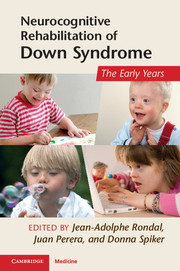Book contents
- Frontmatter
- Contents
- List of contributors
- Preface
- Acknowledgments
- Section 1 Definition, history, methodology, and assessment
- 1 Early rehabilitative intervention
- 2 The history of early intervention for infants and young children with Down syndrome and their families
- 3 Advances in clinical endpoints for neurocognitive rehabilitation in Down syndrome
- Section 2 Genetics, brain, and animal models
- Section 3 Pharmacological and medical management and treatment
- Section 4 Early development and intervention
- Section 5 Therapeutic perspectives
- Conclusions
- Index
- References
3 - Advances in clinical endpoints for neurocognitive rehabilitation in Down syndrome
Published online by Cambridge University Press: 05 July 2011
- Frontmatter
- Contents
- List of contributors
- Preface
- Acknowledgments
- Section 1 Definition, history, methodology, and assessment
- 1 Early rehabilitative intervention
- 2 The history of early intervention for infants and young children with Down syndrome and their families
- 3 Advances in clinical endpoints for neurocognitive rehabilitation in Down syndrome
- Section 2 Genetics, brain, and animal models
- Section 3 Pharmacological and medical management and treatment
- Section 4 Early development and intervention
- Section 5 Therapeutic perspectives
- Conclusions
- Index
- References
Summary
Considerable progress in our understanding of the cognitive profile of Down syndrome (DS) has occurred in the last decade. Complementing this progress has been a series of landmark studies highlighting promise for pharmacological intervention for cognitive deficits in this population (Fernandez et al., 2007; Salehi et al., 2009). Movement forward has also been demonstrated by the development of behavioral cognitive interventions targeting specific aspects of the cognitive profile (e.g. Fidler et al., Chapter 15 of this book). With pharmacological and behavioral clinical trials coming to fruition in the next few years, there is an immediate need for valid and reliable clinical endpoints in DS. These trials will only be meaningful if they include a battery of measurements that are well suited for this population and sensitive enough to detect change. Our group has been involved in the development of such a battery, the Arizona Cognitive Test Battery (ACTB) (Figure 3.1), which serves as a foundation for assessing characteristics of the phenotype of DS.
The history of pharmacological and dietary interventions for the cognitive deficits in humans with DS is largely one of disappointment (Salman, 2002). A number of drugs [e.g. drugs used in Alzheimer's disease, such as donepezil (Prasher et al., 2002)] or dietary supplements currently on the market have been tested for use in individuals with DS, with little effect on the whole.
- Type
- Chapter
- Information
- Neurocognitive Rehabilitation of Down SyndromeEarly Years, pp. 36 - 51Publisher: Cambridge University PressPrint publication year: 2011
References
- 1
- Cited by



